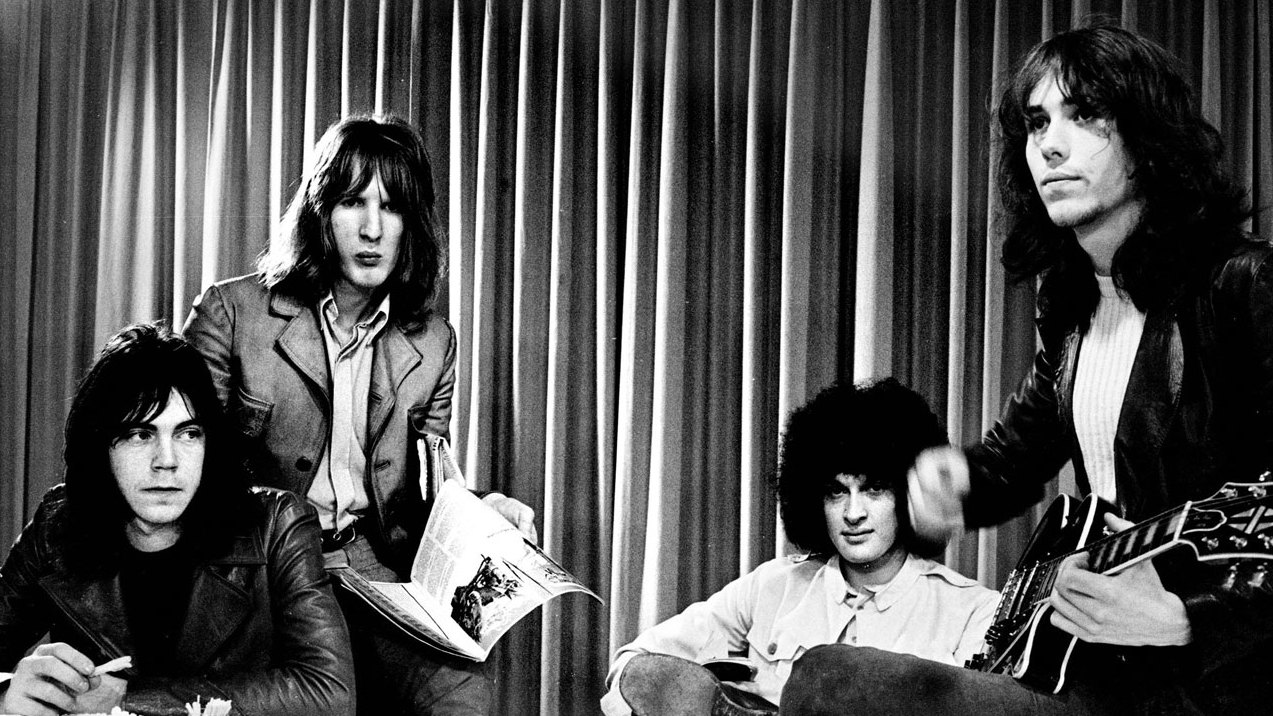10 of the best rock bands from Holland
10 Great Dutch Rock Bands? There's Radar Love and the yodelling classic Hocus Pocus, but does the story really go any deeper or further? You'd better believe it.

There has been a lengthy string of effusive talents to come out of the country that has given us windmills and clogs. In the same way that Dutch football has been revered ever since the late 1960s, so the same is true of Holland’s rock catalogue. From metal to prog, taking in flamboyant personalities and creative introspection, there’s been a steady stream of fine bands. Here are 10 of the best.
Golden Earring
True, they gave us Radar Love. However Golden Earring offer a lot more than this one-off hit. Formed as long ago as 1961, they enjoyed a golden period from the late 60s until the mid-80s, touring with Hendrix, Zeppelin and King Crimson among others. And albums such as Moontan (1973), To The Hilt (76) and Cut (82) showed they had the sort of unique sound which made them an outstanding band. Amazingly, Rinus Gerritsen (bass/keyboards) and George Kooymans (guitar/vocals) – both of whom were founder-members of Golden Earring – are still in the line-up, as is English singer Barry Hay, who joined in 1967. Tits ‘N Ass in 2012 was their seventh number one album at home.
Vandenberg
In the mid-80s, this lot broke out of Holland and were recognised as one of the best hard rock bands around. Led by guitarist Adrian Vandenberg, the sound was melodic, tough yet also full of brilliant musicianship. The foursome recorded their first two albums, 1982’s Vandenberg and Heading For A Storm the following year, at Jimmy Page’s Sol Studios; the debut even had a top 40 US single in Burning Heart. Sadly, by the time of third album Alibi (85), there was considerable friction in the band and it all fell apart. Adrian Vandenberg went on to join Whitesnake and enjoy huge success, but for a while the band named after him looked like they’d become massive in their own right.
Focus
In 1969, Focus emerged from Hair. Seriously, the original line-up consisted of musicians who played in the Dutch production of the play. Very much in the progressive vein, they achieved international acknowledgement in 1971 with the Making Waves album, which had the mega selling single Hocus Pocus, the song that made yodelling cool in rock. This not only underscored the serious depth of talent in the band, but also their musical quirkiness. Focus 3, released later in 72, and Hamburger Concerto in 74 were also hugely successful. They’ve gone through many line-up changes since, and have even split up occasionally, but are still touring and recording, albeit with only Thijs van Leer (keyboards/flute/vocals) remaining from those early glory days.
Sign up below to get the latest from Classic Rock, plus exclusive special offers, direct to your inbox!
Shocking Blue
Very much in the psychedelic vein, Shocking Blue burst out in 1968 with the minor Dutch hit Lucy Brown Is Back In Town, released the year after they were formed in The Hague, But their big song was Venus, which topped the US charts in 1970 and made it to number three in Britain. The combination of female vocals from Mariska Veres and the guitar/sitar waves courtesy of Robbie van Leeuwen suggested Shocking Blue could be a European equivalent to Jefferson Airplane. But sadly, they split up in 1974, after Veres quit. Various attempts at a comeback failed to reach the previous standard. However, their early songs still have considerable merit.
Picture
One of the first Dutch metal bands, Picture were formed in 1979 and as such had a strong connection to the developing NWOBHM scene. But it wasn’t until the arrival of Israeli singer Shmoulik Avigal for 1982’s Diamond Dreamer album (their third) that the band found their rhythm and style. Owing something to Saxon, AC/DC and Ted Nugent (all of whom Picture toured with), Picture made a big impact with 83’s Eternal Dark, even though by this juncture Avigal had left to be replaced by Englishman Pete Lovell. But all the promise and potential of these two albums was wasted through an avalanche of business and personal problems. Picture are still going today, but it was in the early 80s they showed what could have been achieved.
- 10 of the best rock bands from France
- Top Of The Progs: Focus - Hocus Pocus
- Golden Earring: Tits ’N Ass
- 10 of the best rock bands from Germany
Within Temptation
One of the pre-eminent symphonic rock bands of the modern era, Within Temptation were started in 1995 by vocalist Sharon den Adel and guitarist Robert Westerholt. Since then, they’ve guided the band to a growing success. Second album Mother Earth (2000) gave them the hit single Ice Queen, and since then WT have helped to define the genre, with increasingly acclaimed albums and sell out arena tours across the world. However, Within Temptation have always explored different musical avenues, never being content to merely plough through one style. This has given them the individuality to stand apart from their peers.
Brainbox
Starting out in Amsterdam in the late 60s, Brainbox was the brainchild of guitarist Jan Akkerman and drummer Pierre van der Linden. Their feel for combining progressive inclinations with a bluesy hue made them exciting and unique for a while, and the self-titled, debut album in 1969 showed there was a florid sensibility to the attendant musical aptitude. But shortly afterwards, both Akkerman and van der Linden left to join Focus, leaving behind a band who lost all direction, splitting up soon afterwards. When you listen to songs like their version of Tim Hardin’s Reason To Believe, Down Man and Smile from that initial period, the quality still shines.
Herman Brood & His Wild Romance
Herman Brood was a massive character on the Dutch rock scene. His outrageous behaviour and enormous drug habit made him controversial and impossible to control. He relished his reputation as Holland’s most infamous drug addict. Brood went through a lot of different bands, but this was easily his best - in particular the period from 1977-79 - and most long lasting. While the Wild Romance were marketed as new wave, in reality they were full on rock’n’rollers with a thirst for blues. Their best album was 78’s Shpritsz, which overdosed on attitude. In 2001, Brood committed suicide. But this band’s catalogue ensures he has left behind a strong musical legacy, which both reflected his crazed personality yet also proved he was so much more than another casualty of uncontrolled hedonism.
The Gathering
While this band started out in the extreme metal vein, with the release of fifth album How To Measure A Planet? in 1998, a decade after they first formed, The Gathering finally found their true strength. It was here that they displayed a growing desire to experiment with sounds owing a lot to Dead Can Dance and Pink Floyd. This brought vocalist Anneke van Giersbergen more to the fore, and over the next several years The Gathering created music that was both inventive yet also captivating and emotional. Even though van Giersbergen left in 2007, the band have continued to explore their imagination unabated.
Supersister
In the early 1970s, Supersister had a significant artistic connection with the Canterbury scene. Their progressive music was eccentric and a little trippy, having much in common with what bands like The Soft Machine were doing in England. The album Present From Nancy (1970) was affecting and effective, and To The Highest Bidder (71) and Iskander (73, a concept album inspired by the life of Alexander The Great) also made their mark. But 1974’s Spiral Staircase (released under their original name of Sweet Okay Sister) was to be the end of the line for Supersister. Yet, even now these albums still astonish with their clarity and adventure.
Malcolm Dome had an illustrious and celebrated career which stretched back to working for Record Mirror magazine in the late 70s and Metal Fury in the early 80s before joining Kerrang! at its launch in 1981. His first book, Encyclopedia Metallica, published in 1981, may have been the inspiration for the name of a certain band formed that same year. Dome is also credited with inventing the term "thrash metal" while writing about the Anthrax song Metal Thrashing Mad in 1984. With the launch of Classic Rock magazine in 1998 he became involved with that title, sister magazine Metal Hammer, and was a contributor to Prog magazine since its inception in 2009. He died in 2021.

